

PERLEY: Nuclear future beyond Japan. Just as Japan’s earthquake raises fears of catastrophe from a nuclear meltdown and Mideast turmoil jeopardizes the world’s supply of conventional energy, along comes word of a possible scientific breakthrough that holds out the hope of cheap, abundant power.
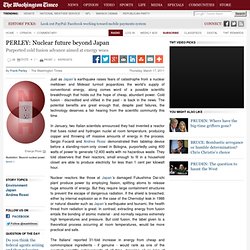
Cold fusion - discredited and vilified in the past - is back in the news. The potential benefits are great enough that, despite past failures, the technology deserves a fair hearing from the scientific community this time. In January, two Italian scientists announced they had invented a reactor that fuses nickel and hydrogen nuclei at room temperature, producing copper and throwing off massive amounts of energy in the process. Sergio Focardi and Andrea Rossi demonstrated their tabletop device before a standing-room-only crowd in Bologna, purportedly using 400 watts of power to generate 12,400 watts with no hazardous waste. Alternatives to oil all have their drawbacks.
It is easy to understand why. Should Google Go Nuclear? Clean, cheap, nuclear power (no, really) FIRST FUSION!!!!!!!!!!!!!!! « Prometheus Fusion Perfection. I’ve been doing trials on the fusor all night.
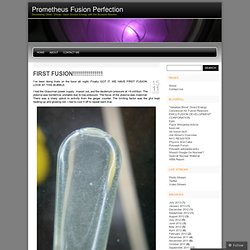
Finally GOT IT. WE HAVE FIRST FUSION. LOOK AT THIS BUBBLE: I had the Glassman power supply maxed out, and the deuterium pressure at ~9 millitorr. The plasma was borderline unstable due to low pressure. This is how it makes me feel: Like this: Like Loading... Fusor. A homemade fusor.[1] A fusor is a device that uses an electric field to heat ions to conditions suitable for nuclear fusion.
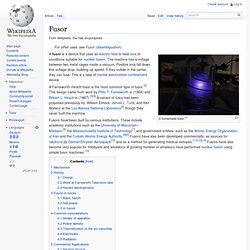
The machine has a voltage between two metal cages inside a vacuum. Positive ions fall down this voltage drop, building up speed. If they collide in the center, they can fuse. This is a type of Inertial electrostatic confinement device. A Farnsworth–Hirsch fusor is the most common type of fusor.[2] This design came from work by Philo T. Fusors have been built by various institutions. Mechanism[edit] For every volt that an ion is accelerated across, it gains 11,604 kelvin. New Copper Coil Polywell on the Scene « Prometheus Fusion Perfection. Researchers at the University of Sydney have made a small Polywell device which looks like this: Powerpoint slides of their research here.
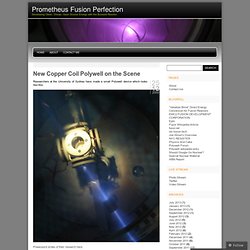
Notice there is no metal exterior on the magrid. As far as I understand… instead of using a magrid with a shell at positive potential (like the WB6 does), they are shooting in electrons with kinetic energy from an electron gun. This seems like a feasible way to build a copper coil polywell. If the researchers are willing and able to share the details of the experiment, I would explore replicating the device and results. Like this: Like Loading... Famulus/decawell - GitHub. Polywell. Polywell WB-6 model assembled The polywell was developed by Robert Bussard as an improvement over the fusor.
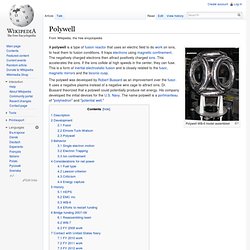
It uses a negative plasma instead of a negative wire cage to attract ions. Dr. Bussard theorized that a polywell could potentially produce net energy. His company developed the initial devices for the U.S. Description[edit] A polywell consists of several parts. Gas is puffed into the cage. Development[edit] Fusor[edit] A homemade fusor Farnsworth–Hirsch fusor during operation in so called "star mode" characterized by "rays" of glowing plasma which appear to emanate from the gaps in the inner grid. Taylor Wilson presenting fusor work to Barack Obama, 2/7/2012 A Farnsworth-Hirsch fusor consists of two wire cages, one inside the other. A benefit of a fusor is that it loses very little energy as light; it has low radiation losses.
Building the Open Source Bussard Fusion Reactor by Famulus. Two years ago, I watched the video "Should Google Go Nuclear," about the unveiling of the Bussard Fusion Reactor, and it felt like a technology with a remarkable potential to alleviate the world's energy crisis.

I also thought, "I can build that thing! " Without university funding, I've been working at my lab in Brooklyn to build the world's first superconducting Bussard reactor, a nuclear fusion technology that promises clean, cheap, abundant energy. I track my progress on the Prometheus Fusion Perfection blog. To date I have fused the atom with a fusor (a step towards building a Bussard reactor). The next step is to replicate the results of the copper coil Polywell built by the university of Sydney. This project is open source and all code, documentation, and intellectual property produced is immediately shared with the community. The money from this fundraiser will go towards three months of research time and the hardware necessary to replicate the Sydney Experiment.